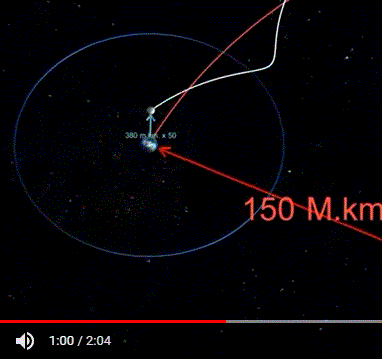by MarkBour » Wed Oct 18, 2017 5:39 pm
Chris Peterson wrote:MarkBour wrote:bystander wrote:<<Youtube video>>Be sure to watch it all.
This lovely animation is not what is happening, though. The moon is not getting closer to the Earth, it is getting farther away (currently, 3.8cm per year).
https://en.wikipedia.org/wiki/Lunar_dis ... astronomy) Perhaps there was some reason for this animation to depict what it is showing, with the Moon spiraling in and colliding with the Earth..
That's not what it was showing. It was showing what the Moon's orbit looks like as you zoom outward to actual scale, and then what it looks like if you make the Earth go away. There was no collision, and none of the orbital distances were changing over the course of the animation.
Hmmm ... the video itself is not titled nor tagged with any explanation that I can see. (Title = "Lunar orbit around the Earth, as Earth orbits around the Sun".) Early in the video, the Moon's orbit clearly shows loops:
Later, the loops are shrinking, and one can see two blue circles drawn, with the one the Moon is "on" shrinking compared to the other one that I assumed was a reference to the earlier orbit:
In this third frame, the Moon is no longer making any loops, I think it is an epicycloid, but I don't really know the terms. You can clearly see it is way inside the blue circle:

- Capture3.GIF (14.93 KiB) Viewed 6102 times
(continued ... Starship Asterisk does not seem to want to allow me a 4th image.)
[quote="Chris Peterson"][quote="MarkBour"][quote="bystander"]<<Youtube video>>Be sure to watch it all.[/quote]
This lovely animation is not what is happening, though. The moon is not getting closer to the Earth, it is getting farther away (currently, 3.8cm per year). [url]https://en.wikipedia.org/wiki/Lunar_distance_(astronomy)[/url] Perhaps there was some reason for this animation to depict what it is showing, with the Moon spiraling in and colliding with the Earth..[/quote]
That's not what it was showing. It was showing what the Moon's orbit looks like as you zoom outward to actual scale, and then what it looks like if you make the Earth go away. There was no collision, and none of the orbital distances were changing over the course of the animation.[/quote]
Hmmm ... the video itself is not titled nor tagged with any explanation that I can see. (Title = "Lunar orbit around the Earth, as Earth orbits around the Sun".) Early in the video, the Moon's orbit clearly shows loops:
[attachment=2]Capture1.GIF[/attachment]
Later, the loops are shrinking, and one can see two blue circles drawn, with the one the Moon is "on" shrinking compared to the other one that I assumed was a reference to the earlier orbit:
[attachment=1]Capture2.GIF[/attachment]
In this third frame, the Moon is no longer making any loops, I think it is an epicycloid, but I don't really know the terms. You can clearly see it is way inside the blue circle:
[attachment=0]Capture3.GIF[/attachment]
(continued ... Starship Asterisk does not seem to want to allow me a 4th image.)